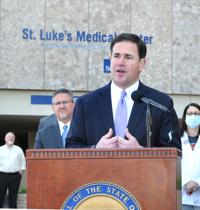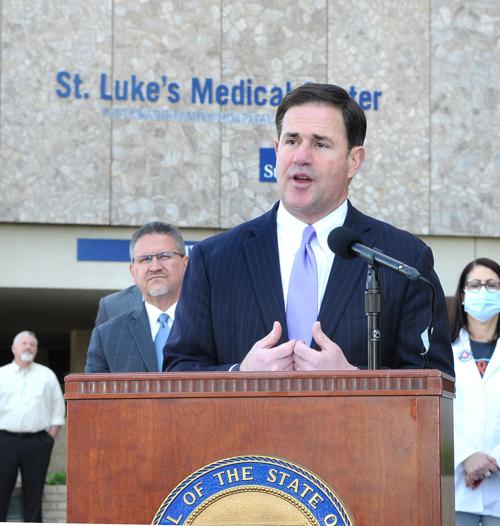PHOENIX – The COVID-19 outbreak is going to blow a billion-dollar hole in state finances.
And about 775 Arizonans will die by the end of May from the virus.
Those predictions came Thursday from the Joint Legislative Budget Committee as staffers said the decline in state revenues plus additional costs to the state from the effects of the virus should leave Arizona with a $1.1 billion budget deficit by the end of the next fiscal year. That’s out of what is basically an $11.8 billion spending plan.
The potential fiscal effects of the pandemic are even more dire.
The report says that $1.1 billion deficit comes even after the state uses close to $1 billion it was expected to have left over by the end of this budget year, which is June 30.
There is one bright spot of sorts. The state does have about $973 million in its “rainy day” fund, a special account set aside for emergencies.
And legislative budget staffers said there will be some relief funds coming from the federal government.
But it also could mean that lawmakers, who until a month ago were planning ways to spend what was expected to be a cash surplus, will now have to find places to cut.
Even if the more immediate revenue shortfall gets addressed, whether with the rainy-day fund or something else, budget analysts are predicting another $1 billion shortfall in the 2021-2022 fiscal year. That’s because the number of people in the state’s Medicaid program is still expected to be high. But by that point, the extra dollars the federal government is providing to help will have disappeared.
Richard Stavneak, staff director of the JLBC, told members of the state’s Finance Advisory Committee who were reviewing the report that making projections at this point is risky.
“Those virus forecasts are extremely speculative and changing weekly,” he said. That starts with projections of the effect on Arizona.
As of Thursday, state health officials had reported 89 deaths from the virus. But Stavneak said the Institute for Health Metrics and Evaluation is predicting that Arizona will end up with 775 virus-related deaths by the end of May.
There is some wiggle room in those numbers, with the institute reporting the total could be as low as 230 or as high as 2,361.
By Memorial Day, though, Stavneak said the number of deaths per day could drop to close to zero.
But that may not be the end. “There is typically a second wave that comes,” Stavneak said.
“The hope is we would be better prepared in terms of mitigation strategies,” he continued. “But we’re still a year out from a vaccine.”
And what that means, Stavneak continued, is that the Arizona economy, driven by income and sales taxes, could take much longer to recover.
Gov. Doug Ducey brushed aside the projections.
“Some of the announcements today are basically guesses,” he said. “No one really knows because the economy is not operating. And without economic activity it’s very hard to make forecasts.”
Economists are looking at the indicators they have to make some forecasts.
Among those is that the Phoenix hotel occupancy rate fell by 71% in the last week of March. That affects not just the tax revenues from the rooms but the fact that people are not coming to Arizona and spending money here.
At the same time, the report says, several restaurant chains have reported a 70% decrease in sales, even with an increase in takeout orders. That is directly related to the directives by Ducey closing restaurants for in-house dining and, more recently, his stay-at-home order restricting travel to essential business.
And then there’s the fact that nearly a quarter-million Arizonans have applied for unemployment benefits in the past three weeks alone. By comparison, total private sector employment in Arizona before the pandemic was about 2.5 million.
“That’s just incredible,” Stavneak said.
Part of the problem with predictions, he said, is that the state is working with only limited data. For example, sales figures for March — and the sales taxes collected — won’t be fully reported until June.
There also are variables in anticipated income tax collections.
The prediction is that withholding revenues – the amount taken out of employees’ paychecks – is expected to drop by 15% as there are fewer people working. And even the decline in the stock market will have an effect when people file their returns, what with no capital gains and people actually declaring capital losses.
Then there’s the expenditure side, notably the Arizona Health Care Cost Containment System, the state’s Medicaid program, with eligibility linked to individual income. He said there was a 2.3% increase in enrollment at the beginning of this month alone.
What all that means, he acknowledged, is that $1.1 billion shortfall could be as little as $600 million — or as much as $1.6 billion.
Stavneak said that’s why he’s not urging state lawmakers to craft solutions at this point given the variables. He said his staff should have better numbers in June.
Still, Stavneak said, there is some work that can be done now.
Economist Elliott Pollack, a member of the Finance Advisory Committee that reviews the data, agreed that trying to make accurate predictions is difficult. He called the current situation a “black swan event.”
“You can’t plan for anything like this,” he said. “It’s not because people won’t spend,” he said. “It’s because people can’t spend,” with so many businesses closed.
Pollack also said there is reason to believe there will be a much longer-term financial hangover, even after the virus goes away. He said that “social distancing” may become built-in to individual behavior.
“More people are going to be working from home,” Pollack said.
“You’re going to have more takeout and less eat-in at restaurants, especially if there’s close seating,” he continued. “Airlines are going to have a tough problem getting people into planes.”
And Pollack said there will be fewer vacations to crowded places, “which affects us.”
Pollack said something else could affect the speed of the recovery, what he called the “negative incentives to work.”
He pointed out that the Coronavirus Aid Relief and Economic Security Act adds $600 a week to unemployment benefits. That brings the total in Arizona to $840.
“A lot of people will end up with more money from the CARES Act, once the money starts getting there, than they will get as being employed,” Pollack said.





